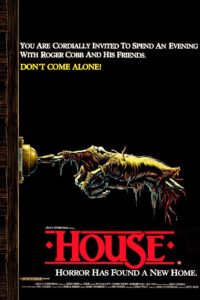 When I first saw House, around the time it came out on home video or HBO in the late 80s, I don’t remember thinking of it as a horror-comedy. Part of the reason for that is that I saw House II first which is more of a comedy with horror elements in it. Putting the two side by side, the first in the series is more than a few shades darker than the second.
When I first saw House, around the time it came out on home video or HBO in the late 80s, I don’t remember thinking of it as a horror-comedy. Part of the reason for that is that I saw House II first which is more of a comedy with horror elements in it. Putting the two side by side, the first in the series is more than a few shades darker than the second.
That’s not to say it’s without humor. In fact, as is often the case in well done horror, it’s the bits of levity that make the horror all the more stark and the characters all the easier to relate to.
House was pretty much an unqualified box office hit (made on a budget of around $3 million and pulling in nearly $19.5 million), with a long life on cable and home video. It brought Willam Katt, who had spent a few years on TV as a bumbling super hero in The Greatest American Hero, back to the big screen and gave him a chance to once again show off some of his dramatic acting chops.
It’s one of my favorite horror films with a Vietnam connection. (And, yeah, that is kind of a sub-genre of horror film from the 70s and 80s, even a little into the 90s in some cases.)
The Plot
Roger Cobb is a Vietnam vet who’s been making a living as a horror writer. At least until his life becomes a real life horror story. His son goes missing while visiting Cobb’s aunt’s house, leading to the shredding of both his marriage and his career.
Not too long after everything in his life comes crashing down, Cobb’s aunt passes away (by hanging herself) and he inherits the house. Well behind on the deadline to finish his next book, and with nowhere else to go, he moves into his aunt’s house.
Between writing and renovating the property, he begins to have odd experiences, many of them related to his time in Vietnam… but also a number of truly paranormal and otherworldly encounters.
Eventually, he discovers a portal to a dark and twisted supernatural realm (in the bathroom medicine cabinet) and gets pulled through. He discovers that his son was also pulled into this nether realm and finds him (miraculously) still alive (and sane). Father and son fight their way back into the real world, culminating in Cobb finally facing his fear and guilt about Vietnam and destroying the house.
Subtext and Parallels
When this movie came out, Post-Traumatic Stress Disorder was kind of a new thing in the public consciousness. The ravages of the war plus the lack of support for veterans when they returned from Vietnam had contributed greatly to a number of problems for those men. There was a lot of commentary on this surfacing in horror and other genre fiction at the time–both in print and on screens large and small (there’s a fantastic episode of The New Twilight Zone called “Nightcrawlers” that I can’t recommend enough).
In House, Cobb is a man who came back from the jungle when many friends of his did not. He’s been channeling a lot of that into his horror fiction, but, when his son vanishes, the new trauma dredges up all the old. Among all the more typical “haunted house” stuff and truly bizarre (and unexplained) supernatural creatures that show up in this movie, the most menacing is Big Ben (played by Richard Moll), the buddy who Cobb left for dead, only to find out later he didn’t die before he was tortured by the Viet Cong.
That survivor’s guilt serves as both the key to Cobb’s suffering and his escape from the hellish otherworld where he’s found himself and his son. These kind of metaphorical and allegorical setups are why horror can be a super-effective way to deal with issues the public–and those suffering directly–otherwise are hesitant to deal with.
Cobb’s triumph and escape–especially since he also rescues his son in the process, atoning in a way for leaving Big Ben behind–is a solidly heroic journey. One which many in the real world face without the proxies of special-effects-generated dark dimensions and skeletal specters of guilt.
The Verdict
There are a few different ways you can watch this movie and get something worthwhile out of it.
You can watch it as a straight up horror film and soak in the dread of Cobb’s missing son and his personal hell for what he didn’t do for his friend back in ‘Nam. Marvel at the effects, especially Big Ben near the end of the film, which were pretty impressive for 1986. You’ll likely come away suitable entertained by the jump scares and overall story.
You can watch is as a study of or metaphor for PTSD and associated trauma disorders. Katt does a great job of playing though those emotions (which is one of the reasons I most certainly didn’t remember the comedy elements in this when I first saw it… some of those emotions are raw). And revel in how, ultimately, not only does he triumph over his problems, but helps save his son from falling prey to the fallout from them.
You can watch it for the comedy bits… which are, indeed, there. Not just in the design of some of the monsters, but in the way a number of the situations are played. This actually downplays the horror aspect of a number of things, but, again, makes the more important horror bits–those with Big Ben–stand out all the more.
Overall, at just over an hour and a half, you really can’t go wrong checking out this film. It’s one of the more solid ones from the time, with an edge that still holds up today (especially now that we’ve been dealing with an influx of soldiers who have “seen too much” in the war zone and struggle with the same problems Cobb does).

Leave a Reply